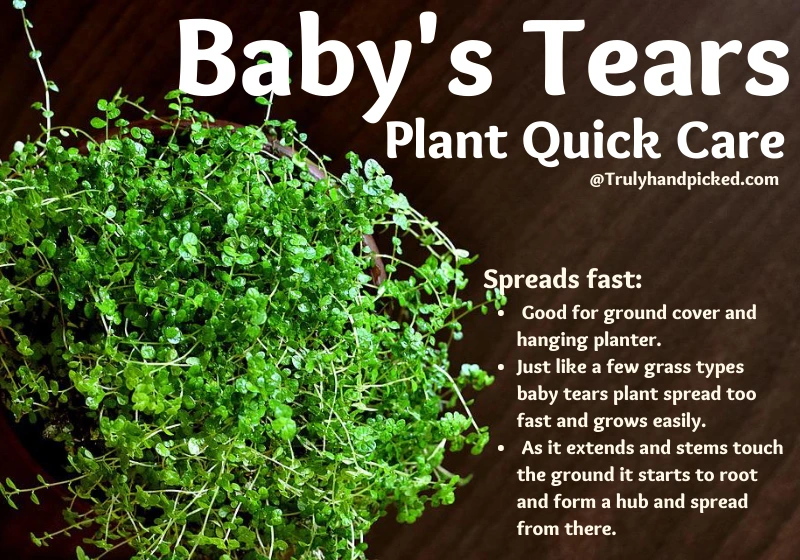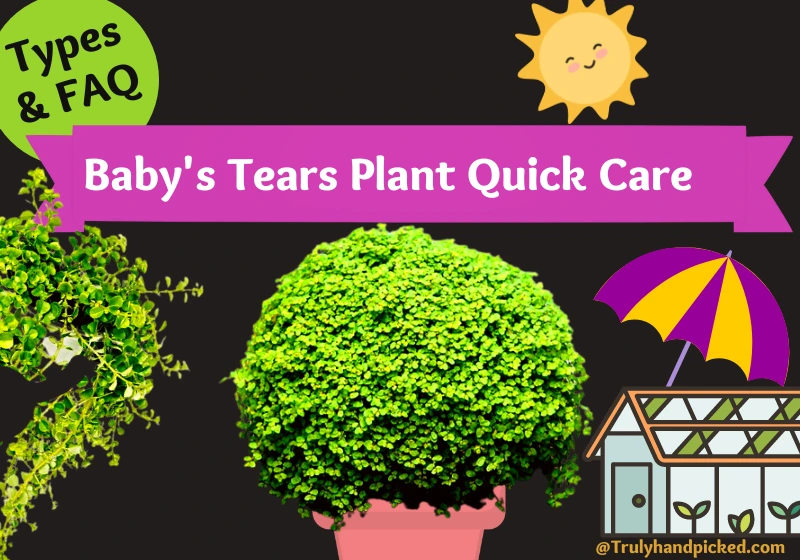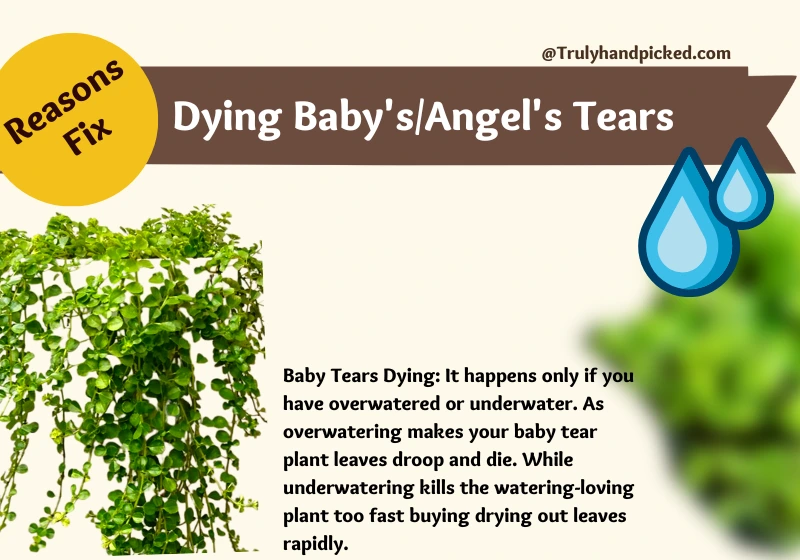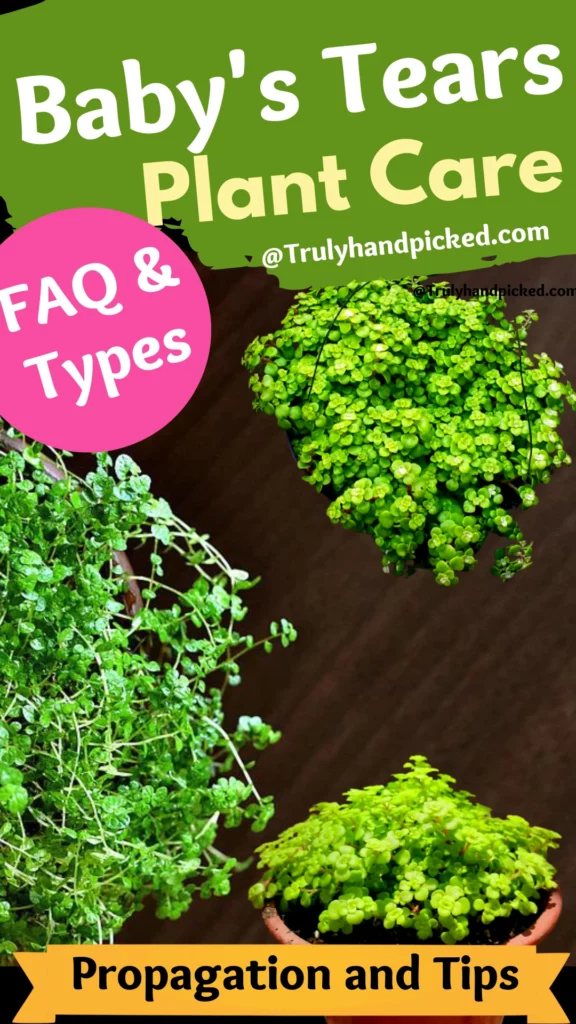Soleirrolia soleirolii is a beautiful ornamental purpose plant that has several other exclusive names including baby’s tears. This species of nettle family usually thrives best in an open outdoor garden with partial shade.
Baby tears plants are best for hanging planters and ground cover, it prefers shade or indirect sunlight. Preferred for its lunch green ornamental foliage and easy maintenance and propagation in spring and summer
Spreads fast: If you plan to grow it as ground cover, yes they are good for it. Just like a few grass types baby tears plant spread too fast and grows easily. As it extends and stems touch the ground it starts to root and form a hub and spread from there.
However, you can let it grow vigorously even as a houseplant by providing its species growing needs suitably. Baby tears plat is a tropical perennial that produces innumerable tiny leaves from compliant stems.
A planter of baby tears plants can brighten up your space in a magical way, especially when they tend to cascade over their planter. All you need to do is just provide the plant’s exact growing climate that it prefers. Here are some basic tips in this regard-
Baby Tears as Indoor Plant: Quick Care Overview
- Planter: A wide shallow pot that has good drainage holes
- Soil: Peat moss rich well-aerated soil that can drain quickly
- Water: Regular watering with a good drainage system
- Fertilizer: Any balanced fertilizer in half the strength form
- Sun Exposure: Partial and indirect sunlight
- Hardiness Zones: 9 to 11
- Blooming time: Late spring to early summer
Toxic for pets? No baby tears plant is safe for pets. They are not succulents, but evergreen creeping perennials that best to grow as lush carpets that spread easily and are safe for dogs.
Dying Baby’s Tears Plant and Plant Care
Signs of a Dying Baby’s Tears Plant:
A struggling Baby’s Tears (Soleirolia soleirolii) plant will often exhibit several noticeable signs of distress. It’s essential to recognize these indicators early to take corrective action and potentially save your plant. Here are common signs of a dying Baby’s Tears plant:
Yellowing Leaves:
Yellowing or browning of the leaves is one of the primary signs of trouble. It indicates that the plant is stressed, which can result from various factors, including overwatering, underwatering, or inadequate light.
Wilting and Drooping:
Healthy Baby’s Tears have an attractive cascading growth pattern with taut stems and leaves. When the plant is unhappy, you may notice wilting and drooping stems and leaves that lose their characteristic vigor.
Leaf Drop:
Leaves may start falling off the plant prematurely. While some leaf shedding is normal, excessive leaf drop indicates stress, potentially due to issues like waterlogged soil or inadequate humidity.
Stunted Growth:
A healthy Baby’s Tears plant exhibits rapid, lush growth. If you notice that your plant’s growth has slowed down significantly or that it’s not producing new foliage, this could be a sign of trouble.
Discolored or Moldy Soil Surface:
An unhealthy plant’s potting mix may develop discoloration or mold on the surface. This can be a sign of overwatering or poor soil aeration, both of which can harm the roots.
Root Rot:
If you gently lift the plant from its pot and observe mushy, brown, or foul-smelling roots, your Baby’s Tears may be suffering from root rot, a common issue when overwatered.
Pest Infestations:
Keep an eye out for pests like aphids, mealybugs, or spider mites on the leaves and stems. The presence of these insects can stress the plant and lead to its decline.
Yellowing Growth:
If the tips of your Baby’s Tears are turning yellow, it may be a sign of nutrient deficiencies or improper watering practices.
Leaf Browning or Burn:
Brown, crispy leaf edges can indicate inadequate humidity or exposure to direct sunlight, causing leaf burn.
Mildew or Mold Growth on Leaves:
The development of white or grayish mildew or mold on the leaves can signify poor ventilation or excessive humidity.
How to Revive a Dying Baby’s Tears Plant
Regularly monitor your Baby’s Tears plant and adjust care practices as needed. With the right attention and care, you can often revive a struggling plant and restore its lush beauty.
1. Watering Issues:
- Overwatering:
- Allow the top inch of the potting mix to dry out before watering.
- Ensure the pot has drainage holes to prevent waterlogged soil.
- Consider repotting in a well-draining mix if the current soil retains too much moisture.
- Underwatering:
- Water your Baby’s Tears when the top inch of the soil feels dry to the touch.
- Place a saucer filled with water and pebbles near the plant to increase humidity.
2. Light Problems:
- Insufficient Light:
- Provide bright, indirect light for your plant. A north-facing window or filtered sunlight through curtains is ideal.
- If natural light is insufficient, consider using a grow light to supplement.
- Excessive Light:
- Move the plant away from direct sunlight, which can scorch the leaves.
- Filter intense sunlight with sheer curtains or blinds.
3. Humidity and Temperature:
- Low Humidity:
- Increase humidity around the plant by misting it regularly or using a humidity tray.
- Group your Baby’s Tears with other plants to create a microclimate with higher humidity.
- Temperature Extremes:
- Avoid placing the plant near heaters, radiators, or drafty windows.
- Maintain a consistent room temperature, ideally between 65-75°F (18-24°C).
4. Pest Control:
- Aphids, Mealybugs, or Spider Mites:
- Inspect the plant for pests and remove them manually if possible.
- Use a mild soap and water solution to gently wash the plant, removing pests.
- Isolate the affected plant to prevent pest spread.
- Fungal or Mold Issues:
- Improve air circulation around the plant by using a small fan.
- Ensure the potting mix isn’t consistently wet, as this can encourage mold growth.
- Consider repotting with fresh, well-draining soil if mold persists.
5. Root Health:
- Root Rot:
- Check the roots for rot, and trim away affected parts.
- Repot your Baby’s Tears in fresh, well-draining soil.
- Adjust your watering practices to prevent future overwatering.
6. Nutrient Deficiencies:
- Yellowing Tips:
- Provide a balanced, diluted liquid fertilizer during the growing season (spring to early autumn).
- Follow the recommended fertilizer dosage, as excessive feeding can harm the plant.
How to Take Care of Baby Tears Plant:
Now take a look at the detailing of how to care for a baby tears plant beautifully, even if you are cultivating it as a houseplant-
Soil and Potting Mix:
- Prepare your soil with peat moss and make sure it stays in loamy form while you are doing the plantation
- Keep the soil pH slightly acidic between 5.0 to 6.0
- Use any commercial potting soil as the medium and make sure it drains quickly as much as you can
Baby Tears Dying: It happens only if you have overwatered or underwater. As overwatering makes your baby tear plant leaves droop and die. While underwatering kills the watering-loving plant too fast buying drying out leaves rapidly.
How often to water:
- Water your baby tears plant regularly and never let the plant wilt for less watering
- Watch for the draining system vigilantly, every time you water your plant thoroughly
- Try to water your plant irregularly during winter
- Water to keep the soil moist enough but not soggy is the thumb rule
Fertilizer for baby tears: You can opt for slow-release fertilizers or liquid fertilizers to feed during spring and summer. And change your watering schedule for fall and winter and avoid feeding in winter. Occasional watering is enough during fall and winter.
When and How to Fertilize:
- Try to make the soil rich enough during the plantation with organic plant food
- Apply compost, humus, or normal animal manure to feed your plant adequately
- And try to feed them in liquid form twice a month during peak spring and summer
Sunlight Needs and Climate:
- Indoor baby tears plants need to stay in a normal warm climate
- Keep the temperature between 50 to 70 degrees F with a high humid climate
- Place your planter in either the kitchen or bathroom to provide indirect but bright light with proper humidity
Pruning and Repotting:
- Prune your baby tears plant when it overgrows the planter uncontrollably
- Trim the overgrown stems or discolored leaves will improve the whole appearance noticeably
- This will also encourage the new growth of your baby tears plant effectively
- Repot your plant when it seems over-bushy and can’t get managed by its current planter
- Use a 2-3 inches wider planter with a whole new potting mix whenever you repot a baby tears plant
Troubleshoots and Solutions:
- Some common pests and diseases of this plant are aphids, scales, and whiteflies
- While discolored leaves, wilted stems, root rot, and stunted growth are some other issues you may face here
- Try to apply neem oil, dish soap, or rubbing alcohol to keep them safe from pests and bugs
- On the other hand, maintain your plant in a proper climate, and take care properly with essential caring methods. Also, keep the plant clean from any kind of debris or untidy buildups to prevent the rest problems at bay.
Types of Baby Tears Plant/Angels’ Tears:
You can find this beautiful greenery baby tears plant in a few specific types. These categories emerge due to the differently designed foliage. Each category similar provides a cascading view but in quite dissimilar shades. Some common baby tears plant types are-
- Golden queen baby tears plant
- Silver queen baby tears plant
- Alba baby tears plant
- Variegata baby tears plant
- And Aurea baby tears plant
- Golden Queen Baby Tears Plant:
This category produces leaves with golden margins over a light green surface. This is a less-thirsty species of baby tears plant, which thrives best in low-light and high-humid spaces quickly.
- Silver Queen Baby Tears Plant:
It is the most easy-to-grow type of baby tears plant that provides normal green foliage with silvery polish. This species is the best pick for garden beds instead of indoor planters.
- Alba Baby Tears Plant:
Alba baby tears plant also produces tiny green leaves with silvery touch. However, its silver coating is more prominent than the silver queen’s foliage. This is one of the quickest-grower types of the Soleirolia soleirolii plant.
- Variegata Baby Tears Plant:
Variegate baby tears plant is probably the best-looking category of this species. It produces foliage in a light green shade with stipples of white color. This category resembles mesmerizing during its blooming season by blooming pink flowers around their unique foliage.
- Aurea Baby Tears Plant:
Aurea is the densest version of soleirolii soleirolii species. It produces leaves with a beautiful combination of gold and green with a catchy shine. This category couldn’t thrive as widely as its other equivalent species and thrive best while sowing in the ground directly.
How to Propagate Baby Tears Plant:
Propagating or regrowing a baby tears plant is effortless like any other normal houseplant. Let’s see how to reconcile your baby tears plant easily at home despite its gentle features-
Propagation Through Cuttings:
- Bring a fully sterilized scissor or pruner and find out the healthiest stem of your plant
- Cut it out with 2 inches length along with the nod and wash the entire part carefully
- Now pluck off the bottom leaves and keep only the top leaves onto the stem
- Prepare a planter with potting soil and make it evenly moist by misting it with distilled water
- Then, dip the cutting into the container of rooting hormone and sow it in the planter
- You can make the bottom of the cutting a bi after applying rooting hormone to get a faster outcome of your process
- Place your planter in a high-humid place where it can get indirect sunlight consistently
- You can even cover the planter with a plastic cover the make the humidity more appropriate for rooting
- Check the progress attentively and you will find that the new cutting will start regrowing within 3-4 weeks healthily.
Propagation through Division:
- Wait for the repotting session to propagate your baby tears plant easily
- Now, divide the plant along with its roots with the help of a trowel
- Once you have divided them perfectly, clean the roots from congested soil and lose them a little
- Prepare some planters with rich and loamy potting soil that drains quickly
- Now, plant each division of that baby tears plant individually in the different planters and let them thrive naturally.
Quick Recap on Reviving a Dying Baby’s Tears Plant
Early Intervention is Crucial: Recognizing signs of distress early and taking prompt action significantly increases the chances of saving your Baby’s Tears plant.
Adjust Watering Practices: Overwatering and underwatering are common culprits for plant decline. Allow the soil to partially dry between waterings, and ensure proper drainage.
Optimal Lighting Conditions: Provide bright, indirect light for your Baby’s Tears. Avoid direct sunlight, which can harm the plant. Supplement with grow lights if natural light is insufficient.
Maintain Proper Humidity: Baby’s Tears thrive in higher humidity environments. Use methods like misting, humidity trays, or grouping plants to create suitable moisture levels.
Temperature Consistency: Avoid extreme temperature fluctuations and protect the plant from drafts and heating sources.




